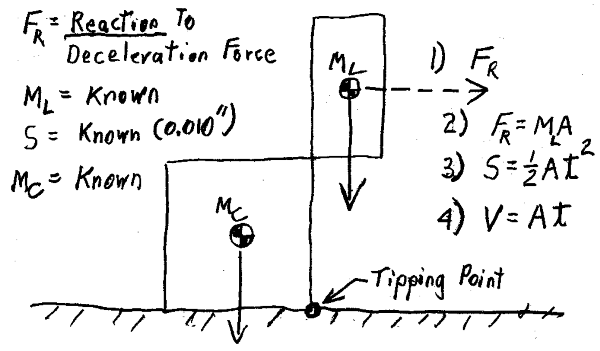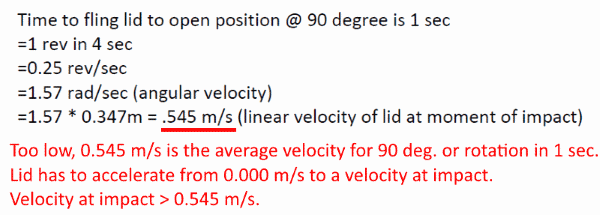Hello,
I read few threads about tipping hazards on here and have used some of the info to attempt a solution.
I have attached a PDF with all of the info and work.
To summarize, we have a container that has a heavy lid and I want to determine if and at what opening velocity the lid will tip the container.
The lid has considerable mass so I do not want to exclude it from the final "system" so I am assuming when the lid reaches it final open position it "locks" in place and then becomes apart of the system; the system COM reflects this assumption.
The system COM will follow an arc with radius 28.53 in (see PDF). Once the system COM begins to move it will be acted on by gravity until it returns to rest. In order for system to tip, the COM has to pass the pinned corner (see PDF). I do not know how to relate the force the system experiences caused by the opening of the lid and the distance the COM travels along the arc. All of my calcs involve constant velocities but I know this is incorrect and its been a long time since I took any of these classes.
Any help is appreciated.
Thank you.
EDIT: I thought some wording was unclear so I added a few more words to where the lid rotates and where the container should tip. USE REV2 PDF FOR REF
I read few threads about tipping hazards on here and have used some of the info to attempt a solution.
I have attached a PDF with all of the info and work.
To summarize, we have a container that has a heavy lid and I want to determine if and at what opening velocity the lid will tip the container.
The lid has considerable mass so I do not want to exclude it from the final "system" so I am assuming when the lid reaches it final open position it "locks" in place and then becomes apart of the system; the system COM reflects this assumption.
The system COM will follow an arc with radius 28.53 in (see PDF). Once the system COM begins to move it will be acted on by gravity until it returns to rest. In order for system to tip, the COM has to pass the pinned corner (see PDF). I do not know how to relate the force the system experiences caused by the opening of the lid and the distance the COM travels along the arc. All of my calcs involve constant velocities but I know this is incorrect and its been a long time since I took any of these classes.
Any help is appreciated.
Thank you.
EDIT: I thought some wording was unclear so I added a few more words to where the lid rotates and where the container should tip. USE REV2 PDF FOR REF

![[idea] [idea] [idea]](/data/assets/smilies/idea.gif)



